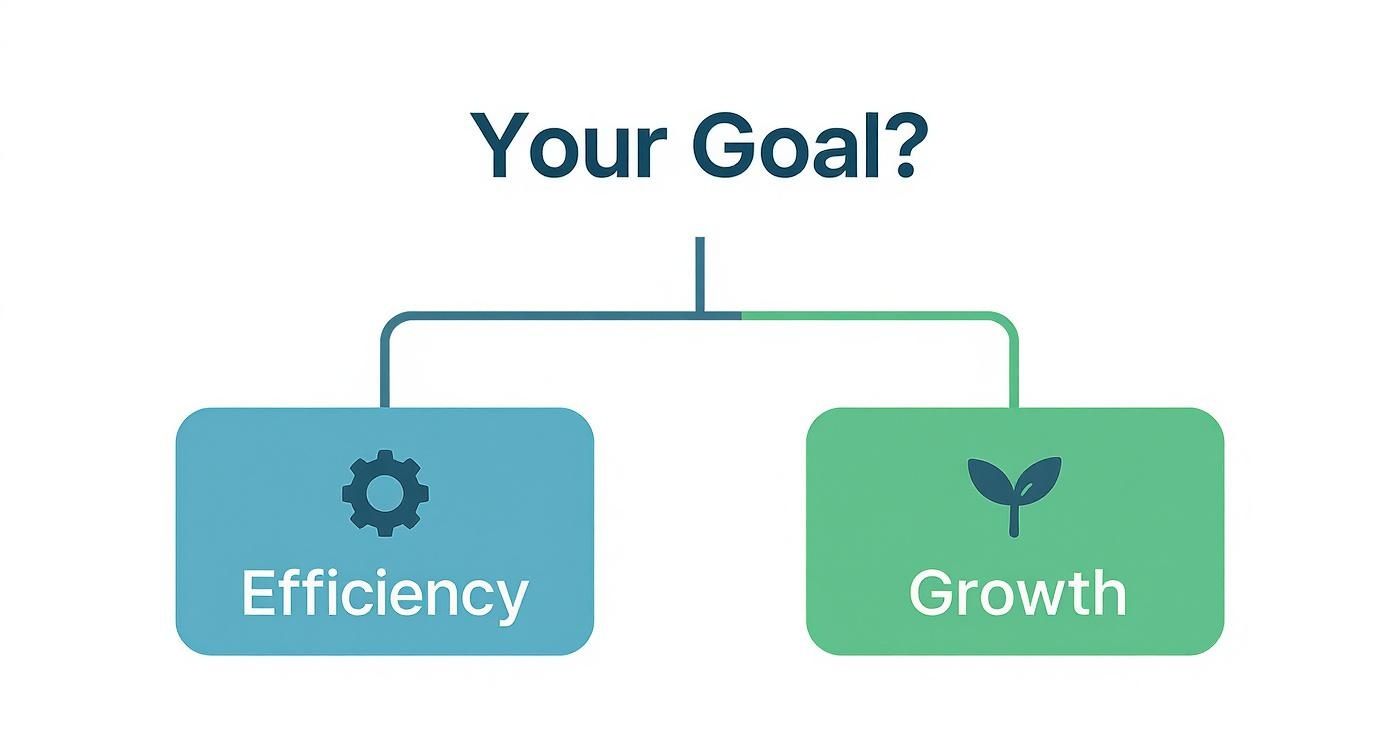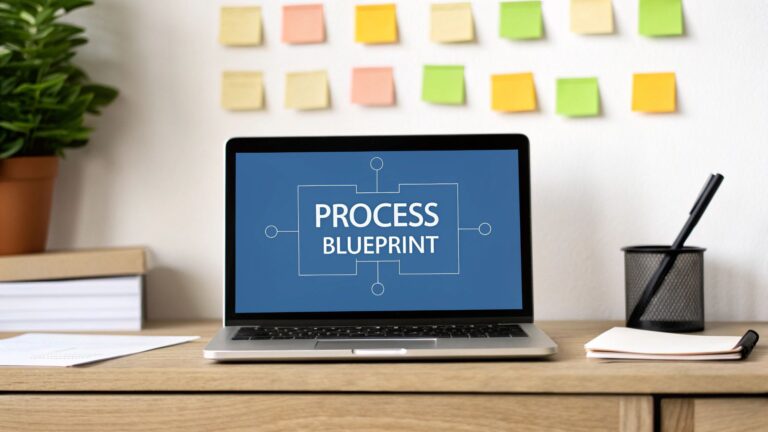Your Guide to Inbound Call Center Software Solutions
When you hear the term "inbound call center software," it might sound a bit technical. But at its heart, it's the mission control for your entire customer service operation. Think of it as the central nervous system that intelligently directs every incoming call, chat, and email to the perfect person to handle it, making sure issues get solved fast.
What Is Inbound Call Center Software Anyway?

Let's use an analogy. Picture an airport's air traffic control tower. Without a system, planes (customer questions) would just show up whenever, trying to land on any open runway. It would be pure chaos. Inbound call center software is that sophisticated control tower, guiding each plane to the right gate for a smooth, safe, and efficient arrival.
This software is the central hub that manages every single inbound interaction, whether it's a phone call, an email, a live chat, or a social media DM. It’s built to bring a sense of order to the often-unpredictable flow of customer needs. Ultimately, its job is to make sure that when a customer reaches out, they connect with the best-equipped person to help them, and they do it quickly.
The Conductor of Customer Conversations
The real magic of inbound call center software solutions is how they orchestrate the entire customer journey. They don't just answer calls; they analyze, route, and track them with incredible precision. It’s like a conductor leading an orchestra, ensuring every agent plays their part at just the right time to create a fantastic customer experience.
Here’s how they pull it off:
- Intelligent Routing: This is the big one. It automatically sends customers to the agent or department with the exact skills to handle their specific problem.
- Reduced Wait Times: Using smart call queuing and offering automated callbacks, the system keeps customer frustration low, even during busy periods.
- Personalized Interactions: By integrating with your CRM, it gives agents a customer's full history the second a call connects, so the conversation feels personal and informed.
- Unified Communications: It brings all your channels—voice, email, chat—into one clean, organized interface for agents.
This kind of organized approach is no longer a "nice-to-have." The global contact center software market hit USD 33.38 billion in 2023 and is expected to grow at a blistering 23.9% annually through 2030. This growth is fueled by one thing: an intense focus on delivering an unbeatable customer experience. You can learn more about the rapid growth of the contact center software market and what's driving these trends.
Curing Common Business Headaches
Every business knows the pain of long customer hold times, disorganized support, and burnt-out agents. Inbound software is specifically engineered to tackle these headaches head-on, turning chaotic workflows into smooth, efficient systems that boost both customer loyalty and team morale.
By organizing and automating the flow of incoming communications, businesses can move from a reactive "firefighting" mode to a proactive, customer-centric strategy. This shift not only improves service quality but also empowers agents to perform their jobs more effectively.
Let's break down some of the most common business problems these platforms are built to solve.
Common Business Challenges Solved by Inbound Software
This table gives a quick snapshot of the everyday business challenges that inbound call center software directly addresses, showcasing its clear value.
| Business Challenge | How Inbound Software Provides a Solution |
|---|---|
| High call abandonment rates | Implements smart call queuing and offers automated callback options so customers don't have to wait on hold. |
| Inconsistent customer service | Provides agents with access to customer history and call scripts to ensure a uniform and high-quality experience. |
| Lack of performance insight | Offers real-time dashboards and analytics to track key metrics like wait times, resolution rates, and agent productivity. |
| Inefficient call handling | Uses skill-based routing to connect customers with the most qualified agent immediately, reducing transfers and resolution time. |
In short, the right software doesn't just manage calls—it transforms the entire support function into a strategic asset for the business.
Core Features That Define Great Call Center Software

To really get what makes inbound call center software solutions tick, you have to look under the hood at the tools that power them. These features aren't just bells and whistles; they're the engine components that transform a simple phone line into a high-performance customer experience machine. Each piece has a specific job, all aimed at making things smoother for both your customers and your agents.
Think of it like this: a basic business phone is a single-lane country road. It gets the job done, but it gets congested fast. A modern call center platform is a multi-lane highway system with smart traffic control, GPS, and live performance data. The core features are what make this efficient system work, getting every customer to their destination quickly and without frustration.
Smart Routing with ACD and IVR
At the very heart of any modern system are two workhorse technologies: Automatic Call Distribution (ACD) and Interactive Voice Response (IVR). They act as your digital receptionists, working together to make sure every caller ends up in the right place.
-
Automatic Call Distribution (ACD): This is the brains of the operation—your intelligent traffic controller. It automatically sends incoming calls to the best-suited agent or department based on rules you set up. For example, a customer who presses the option for "Billing" gets routed directly to a finance specialist, completely skipping the tech support queue. This kind of skills-based routing is a game-changer for reducing transfers and solving issues on the first try.
-
Interactive Voice Response (IVR): This is the friendly automated menu that greets your callers ("Press 1 for Sales, Press 2 for Support…"). A well-designed IVR does more than just direct traffic; it lets customers handle simple tasks themselves, like checking an account balance, which frees up your agents for the more complex conversations where they're needed most.
Many top-tier platforms also integrate advanced SMS capabilities and virtual phone numbers, allowing you to manage customer conversations across even more channels. When you pair these tools with smart routing, you create a truly unified and responsive support hub.
Omnichannel and Unified Communications
Let's face it, customers don't just call anymore. They send emails, use live chat, and message you on social media. A standout feature of modern software is its ability to bring all these conversations together into one single, manageable view. This is what we call omnichannel support.
Instead of your agents frantically switching between different apps and browser tabs, every interaction—no matter where it came from—lands in one unified dashboard. This gives your team a 360-degree view of a customer's entire history, making every conversation more personal and efficient. Imagine an agent seeing a customer's recent email ticket while talking to them on the phone—it’s a much smoother experience for everyone. This concept is a cornerstone of effective automated customer service software, where the goal is to create one seamless workflow.
An omnichannel approach isn't just a nice-to-have anymore; it's what customers expect. Research shows that companies with strong omnichannel strategies retain an average of 89% of their customers. Compare that to just 33% for companies with weak, disjointed strategies.
This unified hub is essential for building a customer journey that feels effortless.
Essential vs. Advanced Feature Comparison
Not all features are created equal, and what you need depends heavily on where your business is at. Some tools are non-negotiable from day one, while others are powerful additions for when you're ready to scale. Here's a quick look at how they stack up.
| Feature | Primary Function | Best For (Business Stage) |
|---|---|---|
| IVR & ACD | Greets callers and routes them to the right agent/department. | Essential (Startups, SMEs) |
| Call Recording | Records conversations for quality assurance and training. | Essential (All stages) |
| Basic Reporting | Tracks core metrics like call volume and wait times. | Essential (All stages) |
| Omnichannel Support | Unifies communication from phone, email, chat, and social media. | Advanced (Growth, Enterprise) |
| AI-Powered Analytics | Provides sentiment analysis and predictive insights from conversations. | Advanced (Enterprise) |
| Workforce Management (WFM) | Forecasts staffing needs and creates optimized agent schedules. | Advanced (Scaling, Enterprise) |
This table helps illustrate that you can start with a solid foundation and add more sophisticated tools as your operational needs become more complex. The key is choosing a platform that can grow with you.
Monitoring and Analytics Capabilities
You can't fix what you can't see. That's why powerful analytics and real-time monitoring are must-have features in any serious call center solution. These tools give managers the hard data they need to boost performance and make smart, strategic decisions.
A good analytics suite will typically include:
- Real-Time Dashboards: A live look at what’s happening right now—call queues, agent status, wait times, and abandonment rates. This lets a supervisor spot a problem as it’s unfolding and make immediate adjustments, like reassigning agents to a busy queue.
- Historical Reporting: Deep dives into key performance indicators (KPIs) like Average Handle Time (AHT), First-Call Resolution (FCR), and Customer Satisfaction (CSAT) scores. This data is gold for spotting long-term trends and evaluating agent performance.
- Call Recording and Scoring: The ability to listen back to calls is vital for coaching and quality control. Many platforms now include tools to score these interactions against a set of standards, helping you ensure every agent delivers the same high level of service.
By using these insights, a business can pinpoint bottlenecks, identify training opportunities, and ultimately turn its call center from a necessary expense into a source of invaluable business intelligence.
How AI Is Changing the Game for Inbound Customer Support

Artificial intelligence has officially moved out of the realm of science fiction and into the daily operations of today's inbound call center software solutions. The goal isn't to replace your best agents with robots. Instead, AI acts as a super-powered assistant, handling the tedious stuff and serving up critical insights on the fly. The outcome? A support experience that’s quicker, smarter, and feels more personal.
This isn't just a passing fad; it's a fundamental shift. The AI market for call centers, valued at USD 1.6 billion in 2022, is expected to skyrocket past USD 4.1 billion by 2027. With roughly 70% of companies already using AI in their contact centers, it’s safe to say this change is already here. You can dig into more stats about the rapid adoption of AI in customer service.
The AI-Powered Front Line: Chatbots
Chatbots are often the first point of contact and one of the most visible forms of AI in action. Think of them as your always-on digital greeters, ready 24/7 to answer basic questions. They excel at handling straightforward queries like, "Where's my package?" or "What are your hours?" This instantly frees up your human team to tackle the more complex problems that actually require a human touch.
But today's chatbots are a far cry from the clunky bots of the past. They’re powered by conversational AI, which helps them grasp the context and intent behind what a customer is saying. This makes the interaction feel less like talking to a machine and more like a real conversation. If you want to dive deeper, we have a complete guide on what is conversational AI.
By taking over as much as 80% of routine customer questions, AI chatbots provide instant resolutions for common issues. This dramatically cuts down on wait times and sets a positive tone right from the start.
Real-Time Backup with Agent Assist
While bots handle the front lines, another type of AI works quietly in the background as a real-time coach for your agents. It's called Agent Assist. Picture this: an agent is on a call with a customer who has a highly specific technical question. Instead of awkwardly placing the customer on hold, Agent Assist listens to the conversation, understands the need, and instantly pushes the right article from the knowledge base directly onto the agent's screen.
This tool is a lifesaver, giving agents the exact information they need, precisely when they need it. It can suggest the best way to phrase a response, walk them through troubleshooting steps, and even ensure they're staying compliant with company policies. This kind of immediate backup boosts agent confidence and has a huge impact on first-call resolution rates.
Understanding the Vibe with Sentiment Analysis
Maybe the most impressive AI tool in the box is sentiment analysis. This technology goes beyond just words; it analyzes a customer's tone of voice, pacing, and word choice to figure out how they're feeling. It can tell the difference between mild annoyance and genuine frustration, giving your agents a massive advantage.
Here’s how it plays out in a real call:
- Detection: The AI picks up on a caller's increasingly frustrated tone based on their word choice and the pitch of their voice.
- Alert: It sends a quiet notification to the agent and their manager, flagging the negative sentiment.
- Guidance: Agent Assist might then suggest a specific de-escalation phrase or even recommend offering a small discount to smooth things over.
This proactive approach lets your team get ahead of a problem before it escalates, turning a potentially bad experience into a story of great service. By understanding the emotion behind the issue, AI helps your team deliver more empathetic and effective support, which is what truly builds customer loyalty.
More Than Just Answering Calls: The Real Business Impact
It’s easy to get lost in the technical jargon of features and integrations, but the true power of modern inbound call center software is how it fundamentally changes your business. This isn't just about managing phone calls more efficiently; it's about transforming your customer service department from a necessary expense into a powerhouse for growth. When you connect the dots, you'll see how these systems create a ripple effect of positive outcomes across the entire company.
The most obvious and immediate win is a huge leap in customer satisfaction. Imagine the difference for a customer who, instead of being put on hold and bounced between departments, is instantly connected to a friendly agent who already knows who they are and what they've called about before. That's not just a faster call—it's a seamless, personal experience that makes people feel heard and valued.
This kind of positive interaction is the bedrock of customer loyalty. When you make customers happy, they stick with you. The numbers don't lie: research consistently shows that boosting customer retention by a mere 5% can increase profits anywhere from 25% to 95%. These aren't just repeat buyers; they become your best advocates, spreading the word and building your reputation organically.
A Smarter, More Efficient Operation
Another game-changer is the massive boost you get in operational efficiency. Think about all the repetitive, manual tasks your agents have to do—routing calls, typing up notes, logging interaction details. The software automates all of that. This frees up your team's time and, just as importantly, their brainpower.
Instead of being buried in administrative work, they can focus entirely on what they were hired to do: connect with customers and solve their problems.
This shift has a direct, measurable impact on performance:
- Shorter Calls: With customer info and solutions at their fingertips, agents solve issues faster, which lowers your Average Handle Time (AHT).
- Fewer Transfers: Smart routing gets the call to the right person the first time, boosting your First-Call Resolution (FCR) rate.
- Happier Agents: When you give your team the tools to succeed and remove the tedious parts of their job, morale goes up and burnout goes down.
Think of it like this: you can either give your team a screwdriver or a power drill. Both can get the job done, but the power drill makes them faster, more precise, and less tired, freeing them up to build something bigger and better.
This efficiency isn't just about saving a few dollars. It's about building capacity. Your team can handle more customer interactions without you having to hire more people, giving your business the room it needs to scale without chaos.
Tapping into a Goldmine of Customer Insights
Finally, every conversation your team has is a piece of valuable data. Modern call center software is designed to capture and analyze these interactions, turning a flood of raw data into crystal-clear business intelligence.
Suddenly, you can spot trends you never would have seen before. Are a lot of people calling about the same confusing feature in your product? That's direct feedback for your development team. Are customers constantly asking a question that isn't answered on your website? Your marketing team now knows exactly what to add to the FAQ. You can even track customer sentiment to see how a new pricing plan is being received in real-time.
By truly listening to the voice of your customer, you can make smarter, more informed decisions about everything from product design to marketing messages. Your call center stops being just a support function and becomes the nerve center of your business—a direct line to what your customers want, need, and think. This is how you stay in tune with your market and keep a step ahead of the competition.
How to Choose the Right Software for Your Team
Picking the perfect inbound call center software can feel like staring at a massive wall of options, each one promising the moon. It's easy to get lost in the noise. But here’s the secret: the "best" software isn't a one-size-fits-all solution. It's the one that fits your team like a glove.
The trick is to start by looking inward at your own operation. Before you even think about watching a demo, you need a crystal-clear picture of what you actually need. Think of it like getting a custom suit made—a good tailor doesn't start cutting fabric without taking your measurements first.
Define Your Core Requirements
Let's start by asking some basic, but critical, questions about your team and your customers. Getting these answers down on paper creates a blueprint for your search, helping you cut through the marketing fluff and focus only on vendors that make sense for you.
- Team Size and Structure: How many agents do you have right now? What about in a year? A small, five-person team has completely different needs than a 50-person department spread across different locations.
- Call Volume: Are you juggling 50 calls a day or 5,000? Your daily and peak call volumes are a huge factor in determining how robust your platform needs to be.
- Essential Integrations: What other software does your team live in all day? Make a non-negotiable list of your must-have integrations, especially your CRM (like Salesforce or HubSpot). A clunky integration will kill productivity faster than anything.
This infographic is a great way to visualize how your main business goal—whether that's getting more efficient or driving growth—should shape your software search.

As you can see, teams laser-focused on efficiency should hunt for features that automate workflows. On the other hand, if you're all about growth, you’ll need tools that can scale up and support new ways of reaching customers.
Prioritize Scalability and User Experience
One of the biggest traps I see businesses fall into is choosing software that only solves today's problems. Your business is going to grow, and your software had better be able to keep up. A platform that seems like a bargain now can quickly become a very expensive roadblock in a year or two.
Scalability just means the software can easily handle more agents, more calls, and even new channels like chat or social media without needing a massive overhaul. Look for cloud-based options with flexible pricing that lets you add users and features as you expand.
Just as important is the user experience (UX) for your agents. If the interface is clunky, confusing, or slow, your team won't want to use it. Adoption will tank, and so will morale and productivity. A great UX is clean, intuitive, and puts everything an agent needs right at their fingertips.
A truly agent-friendly interface doesn't just look good; it reduces cognitive load. It minimizes clicks, automates repetitive tasks, and presents customer data clearly, allowing agents to focus on the human on the other end of the line.
Scrutinize Demos and Calculate True Cost
Once you’ve got a shortlist, the demo phase is where the rubber meets the road. This is your chance to really put the software through its paces. Don't just sit back and let the salesperson run through their standard polished presentation. Come armed with a checklist of real-world scenarios you want to see.
Here are a few questions you should absolutely be asking:
- Can you show me exactly how your software integrates with our CRM?
- How easy is it to add a new agent and get them assigned to the right call queue?
- Walk me through the process of changing our IVR menu. Is that something we can do ourselves?
- What does my agent see on their screen when a call comes in from a customer who’s already in our system?
Finally, look past the shiny monthly subscription fee and figure out the Total Cost of Ownership (TCO). This includes all the potential hidden costs—think implementation fees, charges for priority support, extra costs for certain integrations, or even per-minute calling rates. Calculating the true TCO helps you avoid nasty budget surprises down the road and ensures you’re making a smart financial investment.
Best Practices for a Smooth Implementation
Picking the right inbound call center software solution is a huge step, but the real work starts with implementation. A great rollout is about much more than just flipping a switch; it’s a detailed process that brings together your people, your workflow, and the technology itself. Nailing the execution is how you get the full return on your investment without throwing your customer service operations into chaos.
Think of it like moving into a new, state-of-the-art kitchen. You have all these incredible appliances, but you can't just start cooking a gourmet meal. First, you have to organize your ingredients (that’s your data migration), figure out how the fancy new oven works (agent training), and hook up the dishwasher to the plumbing (integrations). A smooth transition all comes down to having a solid plan.
Planning Your Phased Rollout
Trying to launch everything at once is a recipe for disaster. A much smarter approach is a phased rollout, which lets you test, learn, and adjust with a smaller group before going live across the entire company. This approach minimizes risk and helps build positive momentum for the full deployment.
Here’s a simple checklist to guide your phased launch:
- Data Migration: Start by carefully moving customer data from your old systems. Make sure every piece of contact info, interaction history, and support ticket is transferred accurately. This creates a reliable single source of truth for your agents.
- System Configuration: This is where you design the customer’s journey. Set up your intelligent call flows, IVR menus, and skill-based routing rules to direct callers to the right place, every time.
- Pilot Group Testing: Handpick a small team of your most tech-savvy agents to act as a pilot group. Let them use the system in a real-world setting, listen to their feedback, and iron out any kinks you find.
By the time you're ready for the full launch, this methodical approach ensures the system is already fine-tuned and your team feels ready to go.
Empowering Your Agents Through Training
Even the most powerful software is worthless if your team doesn't know how to use it—or, just as importantly, why they should. Great agent training is about more than just showing people where to click. It’s about getting their buy-in by demonstrating how the new system makes their jobs easier and more effective.
Instead of focusing on features, focus on outcomes. Show your agents how a CRM integration gets rid of tedious manual data entry, or how real-time analytics can help them crush their performance goals. When people see the direct benefits for themselves, adoption rates go way up. You can find more strategies to set up your agents for success in our guide on call center automation solutions.
Key Takeaway: A successful implementation lives or dies by agent adoption. Frame the new software as a tool that empowers your team to provide amazing service, not just another piece of tech they’re being forced to learn.
Finally, don't forget to track your success by establishing clear key performance indicators (KPIs). Monitoring metrics like First-Call Resolution (FCR) and Average Handle Time (AHT) will give you concrete proof of the new platform's impact. It's no surprise that inbound call tracking software alone is seeing huge growth, projected to hit USD 1.884 billion by 2033 as companies work to optimize every customer interaction. You can discover more insights about call tracking software trends and how this technology is evolving.
Frequently Asked Questions
Diving into call center software can bring up a lot of questions. Let's tackle some of the most common ones to help you get a clearer picture and find the right fit for your team.
Inbound Versus Outbound Software
What's the real difference between inbound and outbound software? It boils down to one simple idea: listening versus talking.
Inbound software is all about handling communication that comes to you, like a customer calling for help. Its main job is to get that caller to the right person, fast, using tools like ACD for smart routing and IVR for self-service.
On the flip side, outbound software is built for making calls out to people, like for sales or surveys. It's packed with features designed to make that process efficient, such as predictive dialers that connect agents to live calls and tools to manage entire campaigns. Each one solves a very different business need.
How Software Integrates with a CRM
This is where the magic really happens. A solid integration connects your call center software directly to your Customer Relationship Management (CRM) system. The moment a call comes in, the agent sees the caller's entire history pop up on their screen—no frantic searching required.
When your software and CRM talk to each other seamlessly, you eliminate tedious data entry, cut down on call times, and give your agents all the context they need to solve problems on the very first try.
Most modern platforms have built-in integrations for major CRMs, and for everything else, they offer flexible APIs to create custom connections.
Is This Software Affordable for Small Businesses?
Yes, absolutely. The game has completely changed thanks to cloud-based software and subscription pricing. You no longer need a server room full of expensive hardware or a dedicated IT crew just to run a professional call center.
Today, you can find scalable, pay-as-you-go options that let small teams manage calls like a major enterprise. This flexibility means you can deliver top-tier customer service that rivals the big players, all without a massive upfront investment.
At MakeAutomation, we specialize in implementing AI and automation frameworks that help B2B and SaaS companies scale. Whether you need to optimize your inbound call flows or deploy a voice AI agent, we provide the expertise to streamline your operations. Discover how we can transform your customer service by visiting us at https://makeautomation.co.







